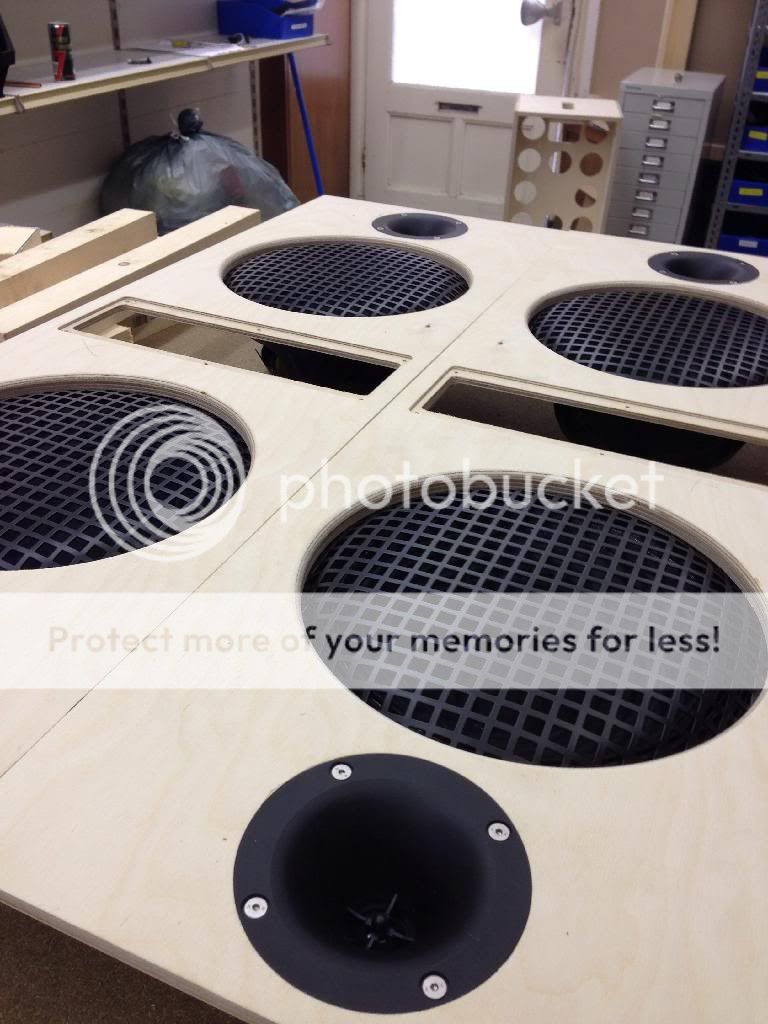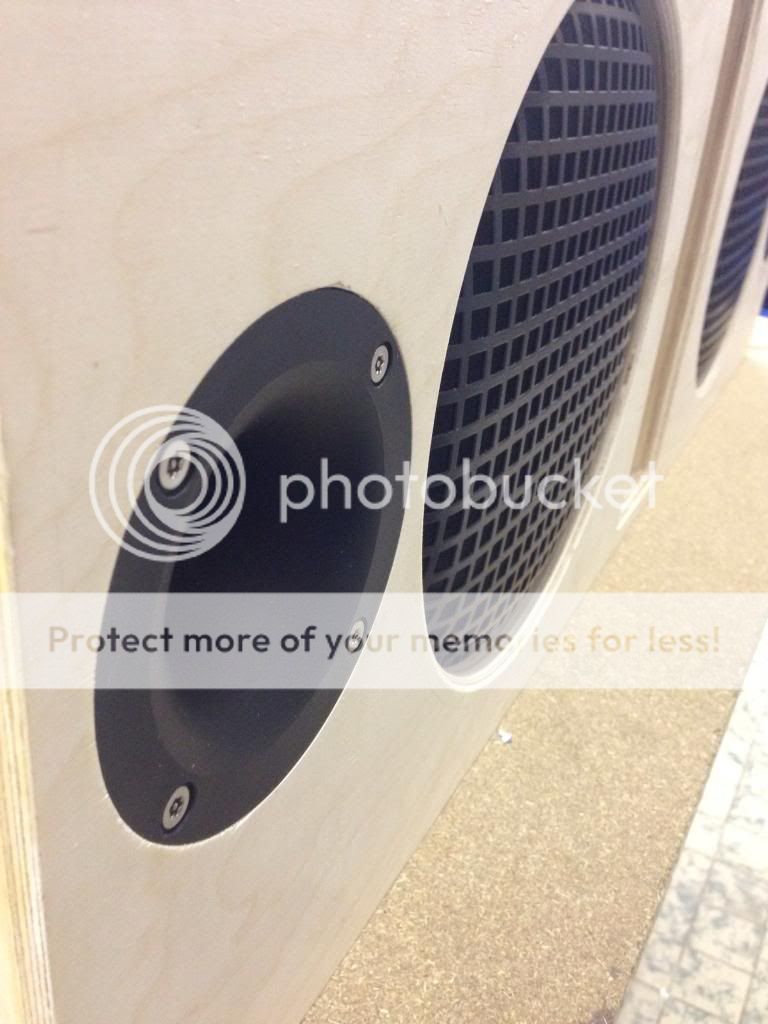That said, I've only got 1 question left before I make the plunge. Question: Is it fair for me to assume that the Boominator-Mini build would be the best starting point for a newbie like me? (i.e. price point, ease of build, availability of components, etc....)
The mini is probably not a good choice for a first build. It's very compact and tolerances are tiny and to achieve a good finish in the end you have to think ahead and make all choices and confirm that these will before you start gluing anything together. And preferably before you even start cutting out wood.
For a relatively compact build the halfinator (just hlf a Boominator) is an excellent choice.
Well... At first I expected to receive them again by the end of May, but that indication got postponed again tot mid June. The filters and the woofers are no problem but the tweeters are impossible to get at the moment  .
.
The filter set can be found here:
Kistradio en Kratradio Specialist - Boominator Sets - Sets
We're also working on a easy to use schematic for the filter components . The bass (bipolar)capacitor is placed in series with the woofer, and a 6.8µF film capacitor is placed parallel across the bass capacitor.
. The bass (bipolar)capacitor is placed in series with the woofer, and a 6.8µF film capacitor is placed parallel across the bass capacitor.
The filter set can be found here:
Kistradio en Kratradio Specialist - Boominator Sets - Sets
We're also working on a easy to use schematic for the filter components
Last edited:
But what's the sounddifference between boominator mini and halfinator - loudness and soundquality-wise?.. I'm thinking the Monacor SP60-8/ND16FA mini vs HP-10W/cheap Piezo from Bluearan Halfinator.. - Both with Maxamp20 AMP
They are designed for different uses really. The halfinator (like the Boominator) is designed for primarily outdoors use. It has higher sensitivity and much higher power capability and is significantly louder than the mini, even on the same amp. The halfinator also makes a good satellite speaker when combined with a suitable subwoofer (like a cubo15) and driven by a larger amp and filtered around 120hz. To that end you can use a neutrik speak-on socket with built-in switches so you can switch between internal and external amp just by plugging in the speak-on plug. (You can naturally do the same with the Boominator as well).
The mini is designed much more like a traditional boombox and can be used both indoors and outdoors without problems.
Sound-wise I'd say they are very similar (not surprisingly) but the mini is much more hi-fi friendly for sure and will with guarantee find itself at home in any active young persons' dorm room that wants the opportunity for music on the go when weather permits. Where the halfinator is a perfect portable mini monitor for outdoors and more professional use.
Last edited:
I have now gathered all the audio components required for my mini Mk2 build (luckily I over ordered on Dayton tweeters when I built my Mini Mk1) but I'm still a little lost on power components .
Please could someone post a few links of the Life4po cells, charger and BMS that would work so that I have some ideas of what to get. I am aware that the batteries pack a fair punch so dont want to make an expensive (and dangerous) mistake. Construction and woodwork I can do with my eyes shut but electrickery is a black art to me.
Please could someone post a few links of the Life4po cells, charger and BMS that would work so that I have some ideas of what to get. I am aware that the batteries pack a fair punch so dont want to make an expensive (and dangerous) mistake. Construction and woodwork I can do with my eyes shut but electrickery is a black art to me.
Well... At first I expected to receive them again by the end of May, but that indication got postponed again tot mid June. The filters and the woofers are no problem but the tweeters are impossible to get at the moment.
The filter set can be found here:
Kistradio en Kratradio Specialist - Boominator Sets - Sets
We're also working on a easy to use schematic for the filter components. The bass (bipolar)capacitor is placed in series with the woofer, and a 6.8µF film capacitor is placed parallel across the bass capacitor.
So the Panasonic 470µF bipolar capacitor that's included in your set IS in fact the bass capacitor? You're writing this on your page: "Because of the same reason the Bass capacitor is not yet added, as its value is still unknown". That was confusing me a bit
Last edited:
So the Panasonic 470µF bipolar capacitor that's included in your set IS in fact the bass capacitor? You're writing this on your page: "Because of the same reason the Bass capacitor is not yet added, as its value is still unknown". That was confusing me a bit
Ah, yes, forgot to remove that! That was because a few weeks ago the actual filter design was not released that. Consider that line removed
More progress:

First side glued up:

Going to do the other side tomorrow, after one final test. Kinda scary considering it's next to impossible to open her up again.
Last edited:
Ah, yes, forgot to remove that! That was because a few weeks ago the actual filter design was not released that. Consider that line removed.
More progress:
<snip...>
Going to do the other side tomorrow, after one final test. Kinda scary considering it's next to impossible to open her up again.
Sweeet! How many are you building and are they all signatures?
Sweeet! How many are you building and are they all signatures?
I know the answer to the last question. These are the 4 last signature drivers known to exist. There will not be produced more. So it's the last and final signature there will be made.
The basslite S2010 is a very capable driver though. And compares fairly well. I will try to make a passive filter for the s2010 and pht407n, so that it can be used without the absolute need for an active filter, though it will still be recommended.
I know the answer to the last question. These are the 4 last signature drivers known to exist. There will not be produced more. So it's the last and final signature there will be made.
The basslite S2010 is a very capable driver though. And compares fairly well. I will try to make a passive filter for the s2010 and pht407n, so that it can be used without the absolute need for an active filter, though it will still be recommended.
How come you recommend an active filter (dsp in this case, I assume) so much rather than a passive? What makes a passive filter so bad?
I'm just surprised because that's what you see in almost every Hifi-speaker you'd buy for your home, and it is standard in the Boominator Mini....
How come you recommend an active filter (dsp in this case, I assume) so much rather than a passive? What makes a passive filter so bad?
I'm just surprised because that's what you see in almost every Hifi-speaker you'd buy for your home, and it is standard in the Boominator Mini....
I have explained why before but to recap. The effective frequency range of the s2010 is quite limited and shouldn't be used over 1800hz-2100hz. At the same time the pht407n should have a cut-off at no lower than 2000hz. So it gives a very narrow overlap window and therefore requires steep filters.
But I've been meaning to update the filter for use with the HP10W anyways. Not because the current filter is bad in any way, it just could be a little better and offer slightly more protection for the tweeter when used with a larger amp than a 12/24V one.
The one I'm planning/working on will work with HP10W, S2010 and GW1058 for crossing to a pht407n with only changing a single resistor.
What is the preferable amp for the Boominator Mini? Is it the MaxAmp20? I've been thinking about using a 2 X 25Watt Class D Audio Amplifier Board - TDA7492 from Sure Electronics and supplying it with 24V. From a recent portable boombox project of mine I had a lot more control of the bass when using 24V instead of 12V. What's your opinion, Saturnus? (and others of course  )
)
Last edited:
Oh, the amp I referred to is only 14-19V. But then maybe an amp like this: 2 X 50Watt Class D Audio Amplifier Board - TDA7492
The mini/micro should not be used with an amp more powerful than 15W per woofer.
All right. That makes sense.
As for reflection and resonance dampening of cabinet walls - what should I use here? I found this one on monacor.dk: MDM-40 gray foam ... Is it overkill? Would something like the MDM-2 be sufficient?
Last edited:
- Home
- Amplifiers
- Class D
- The Boominator - another stab at the ultimate party machine